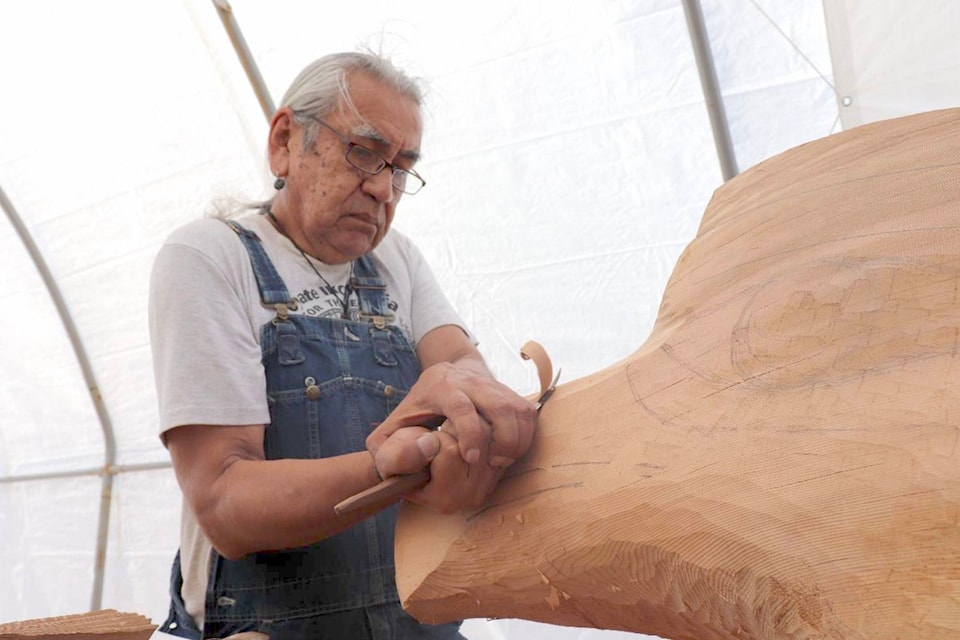As a new participant in the Carving On The Edge festival in Tofino, I was profoundly inspired by the momentum and breadth of activities throughout the week-long event. Wood carving has always been a central activity amongst Indigenous cultures of the West Coast, but that’s not the case in the larger world of consumerism where products are fabricated and disposed of en mass.
The theme of carving as a subject for an annual community symposium is refreshing, unique and intriguing. Each September carvers from up and down the coast assemble in Tofino to share their skills and ideas, and in doing so express their humanity. I felt a collective momentum during the installation of the show in the wonderful Shore Pier gallery space, then, throughout the week, all the artists and toolmakers openly shared their knowledge. The hands-on bentbox making and carving workshops created a contagious enthusiasm for public participation.
The line-up of speakers included Kwakwaka’wakw carver Lou-Ann Kakasolas Neel. She provided a revealing seminar about the major contribution Indigenous woman artists have made, and how they were eclipsed in recorded history. Another speaker, Tseshaht artist and cultural facilitator Kelly Foxcroft-Poirier is a passionate supporter of Nuu-chah-nulth knowledge and values. She conveyed the importance of cultural sensitivity and spoke articulately about issues of appropriation. These speakers brought feminist assertions and a worldly view to the forefront of discussions on cultural property and contemporary artistic practices.
Another surprising presence was the delegation of Tsilhqot’in elders who spoke and danced to their affiliation with the Nuu chah-nulth. They spoke of their shared defence of salmon habitat in the interior of B.C. and the recent successes they’ve accomplished defending their rights in the Supreme Court. In an era of intensified tension between the federal government and Indigenous nations over resource extraction, pipelines, fracking, dams and climate change, their presentation was a powerful confirmation of resolve to defend their territories.
The highlight of the week was the raising of Joe David’s Tla-o-qui-aht totem pole and the community feast. On that blustery day in September, timed to the shrill cries of Joe’s Thunderbird whistles, which sounded like a flock of angry eagles, the large crowd heaved Joe’s pole up in place. It now stands in view of his birthplace, the village of Opitsaht on Meares Island. It heralds the Ha waaiih Hereditary Chiefs and it appears to be a magnetic monument for visitors hungry to see icons of the Indigenous nation of Clayoquot Sound.
I worked as a studio sculptor for the late Haida artist Bill Reid throughout the 1980s when he and Joe David produced bronzes and large architectural commissions for the Teleglobe building in Burnaby. Reid often described Joe David as one of the finest artists on the coast, and to make his visits to Vancouver more productive, Reid would give him keys to his car, home and studio.
I believe Reid’s precedent of support needs to be matched by the region. Joe David is a living treasure and spiritual elder. His practice would be much more productive with a workshop allowing for apprentices — his mentorship would enable them carry this monumental art into the future. This investment would benefit the region through Joe David’s enhanced production of Tla-o-qui-aht art, an art form that has been eclipsed by northern styles in past decades.
Joe holds a profound veneration for his ancestors and he conveys their stories with reverence. As Bill Reid did, he also adapts to contemporary realities to accomplish his studio goals, and acknowledges the good nature of anyone who helps him realize his vision.
At the end of the festival, volunteers swept away the layer of chips at the Shore Pier gallery. Whether Indigenous, settler or tourist, whether we’re from rural or urban lifestyles, what remains is a much broader understanding of our varied expressions and values.
Respectfully,
George Rammell
